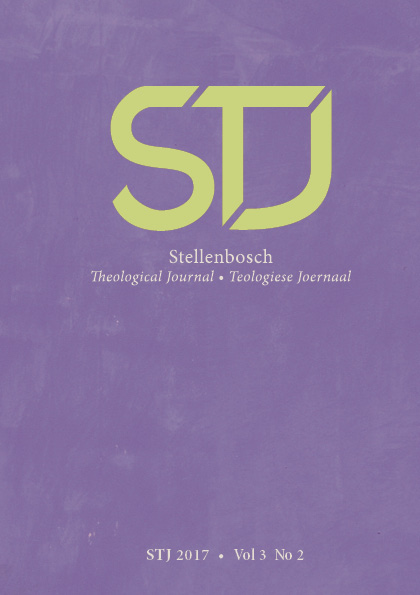Evolusie, Christologie en spiritualiteite – ’n Tweede (post-)aksiale perspektief
DOI:
https://doi.org/10.17570/stj.2017.v3n2.a17Keywords:
Evolution, cosmic Christology, incarnation, suffering, mysteryAbstract
Evolution, Christology and spirituality – a second (post-)axial perspectiveHow can theologians speak anew of Christ and our responsibility towards creation from an evolutionary perspective? It is a question that is embedded in the acknowledgement by scientists such as astro-physicists of the cosmos as mystery on its deepest level. It is a question that is prompted by the unmasking in the second axial period of the myth of autonomous man – a myth that led to the exploitation of the earth as part of a culture of consumerism. It is argued that the proposed answer to the question comes from evolutionary perspectives in which the human being has lost its place as being in the centrum of the cosmos. Instead, being human depends on everything else in the cosmos and is realised in interconnectivity. Making sense of the evolutionary unmasking from newly re-formulated theological perspectives lead to the acknowledgement of God as mystery that has been revealed in a unique way as the Logos in Jesus Christ. These theological perspectives on God find expression in ‘wider’ and ‘deeper’ understandings of Christ from what is called a second person approach. It is an approach that stands over against the objective-ontological third-person approach and the subjective experiential-expressive approach of the first person. The second-person approach is wide in a twofold sense, namely in being relational, and in communicating with human beings and the cosmos as a whole. It is also deep since from an understanding of ‘deep incarnation’ – and also ‘deep suffering’ – it reaches out to the roots (radixes) of creation. It ultimately finds expression in a cosmic Christology that demands of human beings responsibility for the cosmos as gift of God.
Published
How to Cite
Issue
Section
License
Copyright (c) 2017 Danie Dreyer

This work is licensed under a Creative Commons Attribution 4.0 International License.
https://creativecommons.org/licenses/by/4.0/
Authors who publish with this journal agree to the following terms:
Authors retain copyright and grant the journal right of first publication with the work simultaneously licensed under a Creative Commons Attribution License that allows others to share the work with an acknowledgement of the work's authorship and initial publication in this journal.
Authors are able to enter into separate, additional contractual arrangements for the non-exclusive distribution of the journal's published version of the work (e.g., post it to an institutional repository or publish it in a book), with an acknowledgement of its initial publication in this journal.
Authors are permitted and encouraged to post their work online (e.g., in institutional repositories or on their website) prior to and during the submission process, as it can lead to productive exchanges, as well as earlier and greater citation of published work.
Please note that erroneous copyright information is given in the PDFs before Volume 9, 2023.



